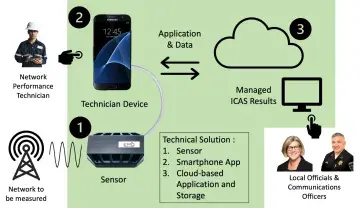When a first responder enters a building during an emergency, they count on being able to communicate with their team at all times. Their safety and their ability to carry out the mission relies on knowing they can reach help and support anywhere that they need to go within a structure. This is why most state and local jurisdictions require that buildings have first responder coverage in every part of a building. While there is not a national requirement for in-building coverage for emergency communications, the overarching need has resulted in the creation of national model codes by the National Fire Protection Association (NFPA) and the International Code Council. Although primarily driven by fire service jurisdictions these requirements are intended to address emergency communications coverage for all first responder disciplines.
The Science and Technology Directorate (S&T) discovered through its Project Responder research that maintaining adequate communications inside buildings was a capability need that first responders wanted to work with S&T to address.
“First responders need constant communications, in fact, their lives are put at greater risk when they do not have constant, reliable communications in buildings. Yet, in many instances, their ability to safely access buildings in response to, for example a fire, is hampered by loss of communications. This can force them to either accept greater risk or more slowly respond to an emergency,” said Cuong Luu, subject matter expert for S&T’s Office for Interoperability and Compatibility Technology Center.
In order to bring new technologies to bear on this problem, the topic “In-building Coverage Analysis System (ICAS) Using Existing First Responder’s Radio and Smartphone” was included in the DHS Small Business Innovation Research (SBIR) Program 20.1 Solicitation. Epiq Solutions, Inc. was selected for a Phase I award and after successfully completing their feasibility study, was awarded a SBIR Phase II contract to continue research and development on their Low Size, Weight and Power (SWAP) In-building ICAS solution for commonly used first responders' network types.
First responders typically rely on agency-issued Land Mobile Radios (LMR) to communicate in indoor settings. The availability of the FirstNet LTE network, a communications network created solely for first responders, is increasingly providing additional indoor public safety data services, such as physiological and health monitoring and location tracking to enhance personnel safety. However, the LMR and FirstNet networks are two completely separate networks—the LMR network is managed by state/local public safety organizations, while FirstNet is built and operated by AT&T through a public-private partnership. So, there remains a void in enabling first responders to record, access, capture and maintain the in-building service availability of each of these two different networks today and for the next five to ten years…and beyond.
There is also not a standardized method for testing and evaluating emergency communications coverage in buildings across jurisdictions. Evaluations depend on specific local regulations and often takes place one time upon completion of new construction. Quite often there is little-to-no follow up testing to see if conditions have changed due to new nearby construction or the modification of internal layouts, and there is no easy way to track and maintain data from previous tests.
“These kinds of reports have a shelf life,” said Cuong Luu. “A building goes in next door, and the conditions can change. Frequent and standardized testing allows for accurate real-time data.”
“In order to get to a place where we can have trusted in-building communications that extends the wide area network into buildings, we need to try to find a way to make testing and evaluation simple and low cost, and then it will be done more effectively and folks can trust the outcomes of it,” said Gary Schluckbier, director of Radio Frequency Sensing at Epiq Solutions.
As a result of the SBIR effort, Epiq Solutions has created PRiSM, a prototype that uses a low-cost sensor that can be connected to a standard smart phone, tablet, or laptop that produces measurements of the signal strength in the most commonly used first responder bandwidths and performance data which is then uploaded to a portal. The portal is a key element of this innovative solution; storing the data in an accessible online repository, where it is available to whoever needs it, whenever it’s needed.

Instead of having a single initial test performed by a network performance technician when a building is issued its certificate of occupancy, with results that may not be easy to find or access, with this solution a building can be retested periodically with the technician only needing a sensor attached to a smart phone, and the new data can be compared to previous results. This data could also be accessed by first responders arriving on a scene, so that they can quickly assess whether they need to deploy additional communications assets.
This is also a potential benefit to building owners and developers. Currently, testing requires complex and expensive equipment as well as highly trained personnel. Furthermore, there are no concrete test requirements from jurisdiction to jurisdiction. The goal is for the compact, low-cost PRiSM design to make it possible to test more often and to facilitate more broadly accepted best practices. In addition, the solution does not require highly trained, costly engineers to collect data further driving down costs.
The next step for this technology is for Epiq Solutions to launch it as a fully available commercial offering.
The SBIR Program provides U.S. based small businesses the opportunity to propose innovative ideas that meet specific homeland security research and development technology needs and is one of the many ways S&T supports first responders. Making sure that local first responders can communicate at the scene of an emergency relies on a lot of important innovations, policies and technologies that are put in place long before the first alarm goes out.
For related inquiries, contact stmedia@hq.dhs.gov.
